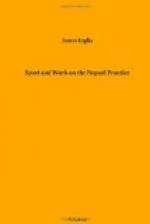Our bag to-day was one tiger, one florican, one mallard, and two widgeon. On cutting the tiger open, we found that the bullet had entered on the left side, and, as we suspected, had entered the lungs. It had, however, made a terrible wound. We found that it had penetrated the heart and liver, gone forward through the chest, and smashed the right shoulder. Notwithstanding this fearful wound, shewing the tremendous effects of the Express bullet, the tiger had gone on for the distance I have mentioned, after which it must have fallen stone-dead. It was a marvellous instance of vitality, even after the heart, liver, and lungs had been pierced. The liver had six lobes, and it was then I heard for the first time, that with the natives this was an infallible sign of the age of a tiger. The old Major firmly believed it, and told us it was quite an accepted article of faith with all native sportsmen. Facts subsequently came under my own observation which seemed to give great probability to the theory, but it is one on which I would not like to give a decided opinion, till after hearing the experiences of other sportsmen.
CHAPTER XXIV.
Camp of the Nepaulee chief.—Quicksands.—Elephants crossing rivers. —Tiffin at the Nepaulee camp.—We beat the forest for tiger.—Shoot a young tiger.—Red ants in the forest.—Bhowras or ground bees.—The ursus labialis or long-lipped bear.—Recross the stream.—Florican. —Stag running the gauntlet of flame.—Our bag.—Start for factory. —Remarks on elephants.—Precautions useful for protection from the sun in tiger shooting.—The puggree.—Cattle breeding in India, and wholesale deaths of cattle from disease.—Nathpore.—Ravages of the river.—Mrs. Gray, an old resident in the jungles.—Description of her surroundings.




